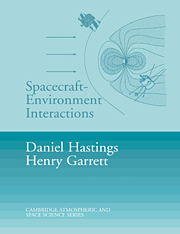Book contents
- Frontmatter
- Contents
- List of Illustrations
- List of Tables
- Preface
- Acknowledgment
- 1 Introduction
- 2 Fundamental Length, Time, and Velocity Scales
- 3 The Ambient Space Environment
- 4 Neutral Gas Interactions
- 5 Plasma Interactions
- 6 The Space Radiation Environment
- 7 Particulate Interactions
- 8 The State of the Art
- References
- Index
7 - Particulate Interactions
Published online by Cambridge University Press: 30 September 2009
- Frontmatter
- Contents
- List of Illustrations
- List of Tables
- Preface
- Acknowledgment
- 1 Introduction
- 2 Fundamental Length, Time, and Velocity Scales
- 3 The Ambient Space Environment
- 4 Neutral Gas Interactions
- 5 Plasma Interactions
- 6 The Space Radiation Environment
- 7 Particulate Interactions
- 8 The State of the Art
- References
- Index
Summary
Particle Impacts on Spacecraft
In this chapter, the effects of space particulates – hypervelocity impacts and scattering – are considered. Hypervelocity impacts, the primary effect of meteoroids and space debris, can be roughly divided into effects on single surfaces (namely, cratering or penetration of single surfaces), spall formation, and double-wall (or Whipple) shield penetration. A major consideration for each of these is the target. For example, if the target is an optical surface, then the damage induced on single surfaces is important. If the target is a tank, then penetration and/or failure of the tank is important and the characteristics of its contents become crucial. For electronic components inside a box, the size and distribution of the spall or spall/impactor products coming off the wall of the box are important. Examples of these factors are discussed below with emphasis on the practical considerations that must be taken into account in arriving at an effective and economical (in mass) protection system. A particularly important issue for meteoroid shielding design has arisen in recent years because of the need to have interplanetary spacecraft carrying nuclear RTGs use the Earth for gravitational assists. To provide adequate safety margins for these missions, which often require hypervelocity flybys of the Earth at distances of 300 km, mission planners must target the vehicle so that it will be extremely unlikely for a meteoroid impact on the spacecraft to lead to an Earth-impact trajectory.
- Type
- Chapter
- Information
- Spacecraft-Environment Interactions , pp. 250 - 270Publisher: Cambridge University PressPrint publication year: 1996
- 1
- Cited by



